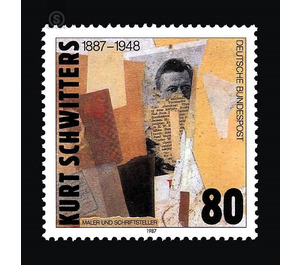100th birthday of Kurt Schwitters - Germany / Federal Republic of Germany 1987 - 80 Pfennig
Theme: Art & Culture
| Country | Germany / Federal Republic of Germany |
| Issue Date | 1987 |
| Face Value | 80.00 |
| Color | brown |
| Perforation | K 13 3/4 |
| Printing Type | 4-color offset printing |
| Stamp Type | Postage stamp |
| Item Type | Stamp |
| Chronological Issue Number | 1199 |
| Chronological Chapter | GER-BRD |
| SID | 964713 |
| In 49 Wishlists | |
Kurt Schwitters was born on 20 June 1887 in Hannover. His artistic as well as his literary work have found an extraordinary reception and succession up to the present day. At the beginning, the naturalistic paintings of the young Hanoverian painter were not to be expected to revolutionize. But at the age of 30 Schwitters developed into an artistic whiz kid. He painted his first abstract paintings and in 1918 immediately got the opportunity to exhibit in Herward Walden's well-known gallery Der Sturm in Berlin. Schwitters glued and mounted tickets, wires, wheels, stones, pieces of wood and much more on paper, canvas or hardboard and fused the materials found through painting into lyrical compositions. Also syllables, letters and numbers are elements of these collages; so in 1919 the syllable "MERZ," which he removed from the original context of the word "commerce," and transferred it to the purposeless sphere of art. From then on he spoke of his work as "MERZ-Art". The emergence of this new art form was related to the period after the First World War: "Broken was everything anyway, and it was a question of building something new ...". The so-called "principle collage" was aimed at establishing relationships between all things in the world. Schwitters also applied this principle to the design of rooms. From 1920 he converted part of his apartment to the so-called "MERZ-Bau". With gypsum and wood by painting and directing the light, he transformed the Gründerzeit rooms into a mysterious art grotto. He himself called this "construction" his life's work. In the 1920s and 30s Schwitters was involved in many important art exhibitions in Germany and abroad. In 1927 he was one of the founders of the artist group »abstract hannover«. His apartment in Hanover became a meeting place for artists and art lovers from all over Europe, who were fascinated not only by the »MERZ-Bau« but also by the personality of Kurt Schwitters. From 1917 Schwitters created a great literary work, which is equal to his artistic work as an aside. In 1919 the poem »Anna Blume« was created, in 1921 the »Ursonate«, a sound poem in sonata form. In analogy to his pictures, he spoke of his poems as "MERZ poetry," since in a similar process he released sentences and sentence fragments from their original context and put them together again. With the recitation of these poems he has aroused admiration and ridicule among his listeners, but never boredom. Schwitters earned his living mainly as a typographer and advertising expert. His original artistic ideas flowed into his advertising designs, on the other hand inspired the possibilities of typographic design to ever new image ideas. Shortly before his "MERZ-Kunst" was presented in 1937 in the exhibition "Degenerate Art" in Berlin as "consummate madness", Schwitters had set out on the path to emigration; first to Norway, later to England. In 1937/38, the collage »Untitled (with an early portrait)« was created in Norwegian exile. Schwitters has integrated into this composition the excerpt from a picture postcard printed in 1919 on the occasion of his first exhibition in Die Sturm. When Kurt Schwitters learned of the destruction of his Hanoverian »MERZ-Bau« in 1943 in exile in England, he suffered a stroke from which he could no longer fully recover. Work on a new »MERZ building« in England remained unfinished; Schwitters died on January 8, 1948 in Ambleside, Lake District. At his death, he was known only to a small circle of art connoisseurs. Today he is considered one of the great inspirers and inventors of 20th century art. (Text: Sprengel Museum Hannover)


